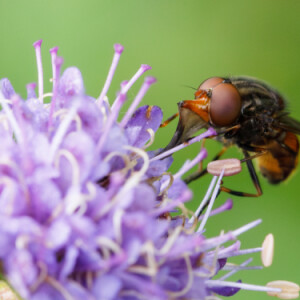Snout
And what a snout it is.
Rhingia campestris is quite a small hoverfly, and thus easy to overlook, but once you've spotted one the only insect with which it could reasonably be confused is its close cousin, Rhingia rostrata. The two are essentially the same size and shape, but R. rostrata is a little brighter and paler in colouring, and crucially, lacks the dark border to the abdomen that you can see on this female R. campestris.
The Wildlife Trusts, who really should know better, refer to this hoverfly as the Heineken Fly, on the grounds that its hugely extendable proboscis allows it to reach the parts that other flies can't reach. Leaving aside the passé cultural reference, this is true: somewhere I have a photo that shows one perching on the outer edge of a dandelion flower, with its tongue stretched right across to the centre of the bloom. However the Trusts also seem to suggest (and they're not alone here) that it's that plague doctor beak that penetrates deep into the flowers, and this is not the case: the snout (or more properly, rostrum) encloses the retracted proboscis, but when the fly is feeding the tongue hinges downwards and outwards underneath it. That's shown reasonably well here and here, but you need to see a Rhingia with its tongue completely stretched - as in my second photo, taken in Trench Wood back in 2021 - to realise how extensive the root of that long proboscis really is, and to see the way it attaches to and is supported by the snout.


Comments
Sign in or get an account to comment.


